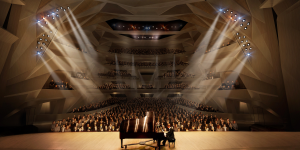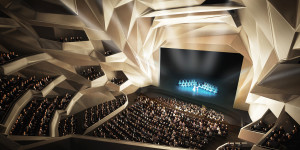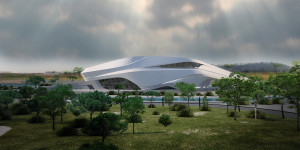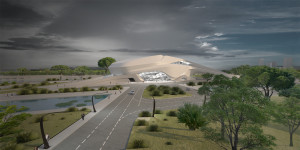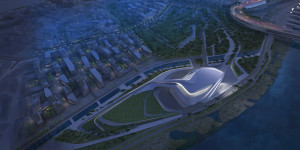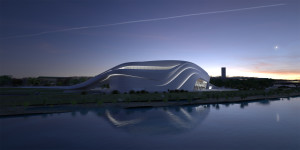Bouregreg’s Valley renewal Agency was authorized by the Decree No. 2-15-245 of the 17th of April, 2015, to establish a subsidiary charged of carrying out the projects of “The Grand Theatre” of Rabat and The Museum of Archeology and Earth Sciences. Established in June 2015, the subsidiary Bouregreg Cultures, a subsidiary of the Agency for the renewal of Bouregreg’s Valley held its first Board of Directors on July 14, 2015.
Through its subsidiary Bouregreg Cultures, the Agency of Bouregreg will develop a cultural infrastructure major at the sequence 2. “The Grand Theatre” of Rabat and the Museum of Archeology and Sciences of the Earth matches In that way the cultural renewal policy and the upgrade of urban heritage throughout the entire Kingdom.
Location
Conceived in the middle of a large esplanade of the “Al Saha Al Kabira” sequence, and facing directly “The Hassan Tower” and the Mausoleum of Mohammed V, The Grand Theatre of Rabat stands as an icon of the cultural and artistic revival of the capital of the Kingdom . The achievement of this work is part of the equipment policy of he cultural infrastructures across the kingdom more precisely in the city of Rabat. It reflects the will of His Majesty King Mohammed VI, to provide the kingdom’s capital of a great theater that
will raise it amongst the great cultural capitals of the Mediterranean.
Project management
The Agency of Bouregreg, developer of the project, has assigned the architectural conception and the monitoring of the works of “The Grand Theatre” of Rabat to the architectural firm of Zaha Hadid. An important agreement was signed in November 2010 in the presence of several concerned ministers, in addition to that of the General director of the Agency of Bouregreg, in order to discuss the project finance.
The estimated overall budget of this project is estimated at 1 677 million dirhams. The project has already achieved several stages. Indeed, the town planning and technical studies are completed, and an international call for tenders has permitted to choose a consortium of companies to carry out the works, which will extend over a period of 40 months. The Grand Theatre in Rabat includes an auditorium, an amphitheater for up to 7,000 people, as well as dressing rooms for artists and spectators, cafes and restaurants.
Architechture
The Grand Theatre in Rabat is intended to be an upscale establishment with a large auditorium which aims to offer an acoustic and a world-class sight lines. The scenographic equipment and the modular acoustic systems will ensure a high quality environment for a variety of uses.
The auditorium of The Grand Theatre in Rabat has a maximum capacity of 1800 seats, including 20 for the disabled. When the orchestra pit is fully lowered, the capacity is about 1,650 seats. When it is half rised, so as to constitute an extension of the stage, the capacity is about 1730 spectators..
The auditorium draws inspiration from the decorative elements ubiquitous in medieval Islamic architecture. The design of the auditorium is conducted in collaboration with ARUP, one of the most recognized acoustician firm in the world.
The inner surface sometimes folds outwards to generate a profusion of seating and lodges that extends from the source point that is the scene which based on a space that seems to capture amoving vitality. The Asymmetric qualities of this multifaceted area evoke dynamism, freedom and a controlled chaos – attributes that are specific to artistic performance. The seats of the Grande Salle are arranged on five levels. A line of visibility, an acoustic and a comfort beyond reproach, these were the primary concerns taken seriously throughout the design process of this space. The auditorium both secure and discrete. In this project, the Salle de Spectacle is also a rehearsal place that fills both the functions of a small stage and also those of a multifunctional space that can be used by musicians as a rehearsal room, by artists such as an informal meetings room or as a space used for formal events.
The interiors are removable and adjustable, enabling the adjustment of the space so that it can be opened to the requirements of different scenarios. The design of seats completes naturally the space of the auditorium offering excellent ergonomics and a huge comfort for the audience. The sightlines are carefully considered so as to provide an exceptional experience The extent of the facets of seat backs and fabric quality allow the absorption and vibration of sound.


